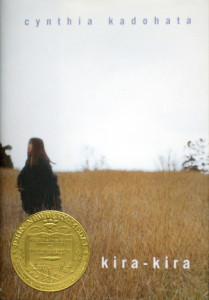 Middle Grade Fiction
Middle Grade Fiction
Age Range: 10-14 years
Grade Level: 5-9
Atheneum Books for Young Readers
Text copyright © 2005 Cynthia Kadohata
Cover photo copyright © 2004 Julia Kuskin
Book design by Ann Sullivan
Jacket design by Russel Gordon
AWARDS
2005 John Newbery Medal
ALA Notable Children’s Books
Asian/Pacific American Award for Literature
Blue Spruce YA Book Award Nominee (CO) Booklinks Lasting Connections
Booklist Editors’ Choice
CCBC Choices (Cooperative Children’s Book Council)
California Collections Capitol Choices List (DC)
Charlotte Award Suggested Reading List (NY)
Dorothy Canfield Fisher Book Award Master List (VT)
Garden State Teen Book Award Nominee (NJ)
KSRC Middle School Titles – Top Pick
Kiriyama Prize Notable Book NYPL
“Books for the Teen Age” Nene Award Master List (HI)
Pacific Northwest Young Reader’s Choice Award
Master List Thumbs Up! Award Master List (MI)
KRISTI’S TAKE
Cynthia Kadohata’s KIRA KIRA is a shining example of a contemporary book for young readers that delves into the prejudices Japanese American kids experienced post-WWII. The first person prose reads simplistically, pointedly and often contains vignettes that feel like they have been torn straight from a journal. A journal, much like Katie Takeshima’s sister’s diary. Kadohata accomplishes this authenticity through her details that always foreshadow, from the first line, all the way to the last line. There’s just enough, but not too much. This mastery of careful observation is also evident in Kadohata’s characters that leap from the page, both perfect and imperfect. I found myself wishing for a sister, just like Lynn, even if it meant experiencing illness and loss, because in the end, the glimmering gift of hope endured.Favorite line
“I keep her diary in a drawer next to my bed.”
ELISE’S TAKE
Katie Takeshima may struggle to find themes in her assigned readings for school, but the themes of persistence, sacrifice, and love clearly permeate her narration. Kira-Kira is described as the Japanese term for glittering or shining, and Kadohata’s writing truly shines when she slows down to reveal a conversation, a car ride, or a family meal. I found myself rushing through Kadohata’s frequent summarizations to get to her next fully realized scene. Kadohata doesn’t focus explicitly on discrimination in this mid-century novel, nor does she leave it out. This Japanese family is not called names or physically harmed, but neither are they included in regular society or given equal opportunities in their Deep South neighborhood. The topic is subtle (often the case with discrimination). In the end, however, familial love and service outshines the community’s prejudices.Favorite line
It was as if the house were healing Lynn. That made me love the house even more than I would have anyway.
MARRAS’ TAKE
For me, a novelist hits a home run when their story makes my laughing tears co-mingle with my sad ones. Cynthia Kadohata hit a homer. Her first- person novel, KIRA-KIRA, seems so genuine, you’d swear she’d written a memoir as a youth. Kadohata welcomes readers into the intimate and difficult lives of the Japanese-American Takeshima family as their middle child, Katie, grows from a 5 year old in the 50s into an adolescent in the 60s. Kadahota covers the topics of family, work, reproduction, friendship, marginalization, and death with such naïve, thoughtful, and inquisitive candor, I came away feeling like Katie Takeshima truly lived and breathed as my quirky childhood friend.Favorite line
When Uncle Katuhisa knocked on the door, I made him give me a password. He said with irritation, “Open up now, young lady, or bear my wrath.” That happened to be the password, so I opened the door.
At the 2014 Society of Children’s Book Writers and Illustrators Summer Conference in Los Angeles, Kahodata shared that her Kira-Kira inspiration came from the life and death of her beloved dog. That must have been one delightful pet.
Please share your KIRA-KIRA comments, too!



